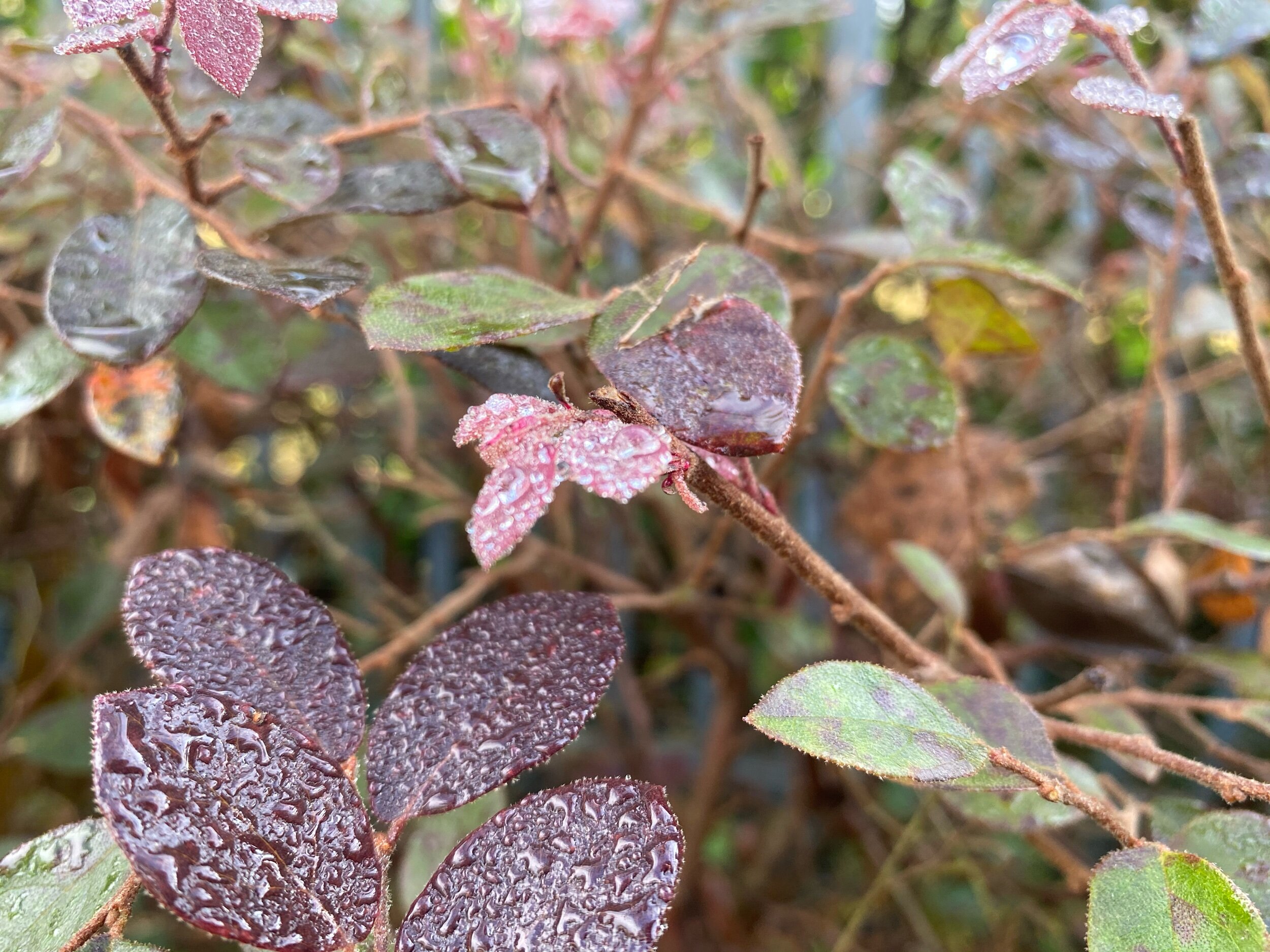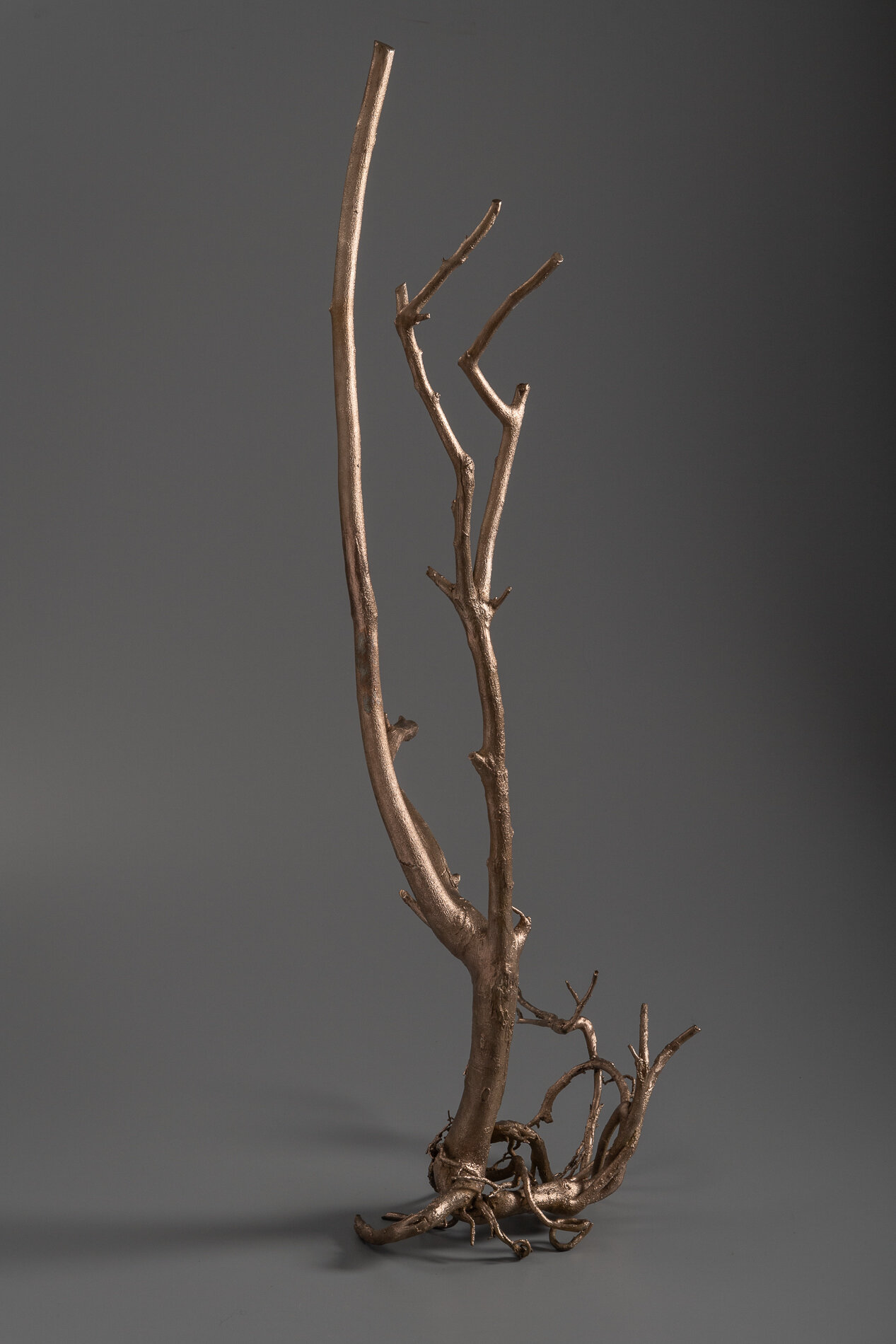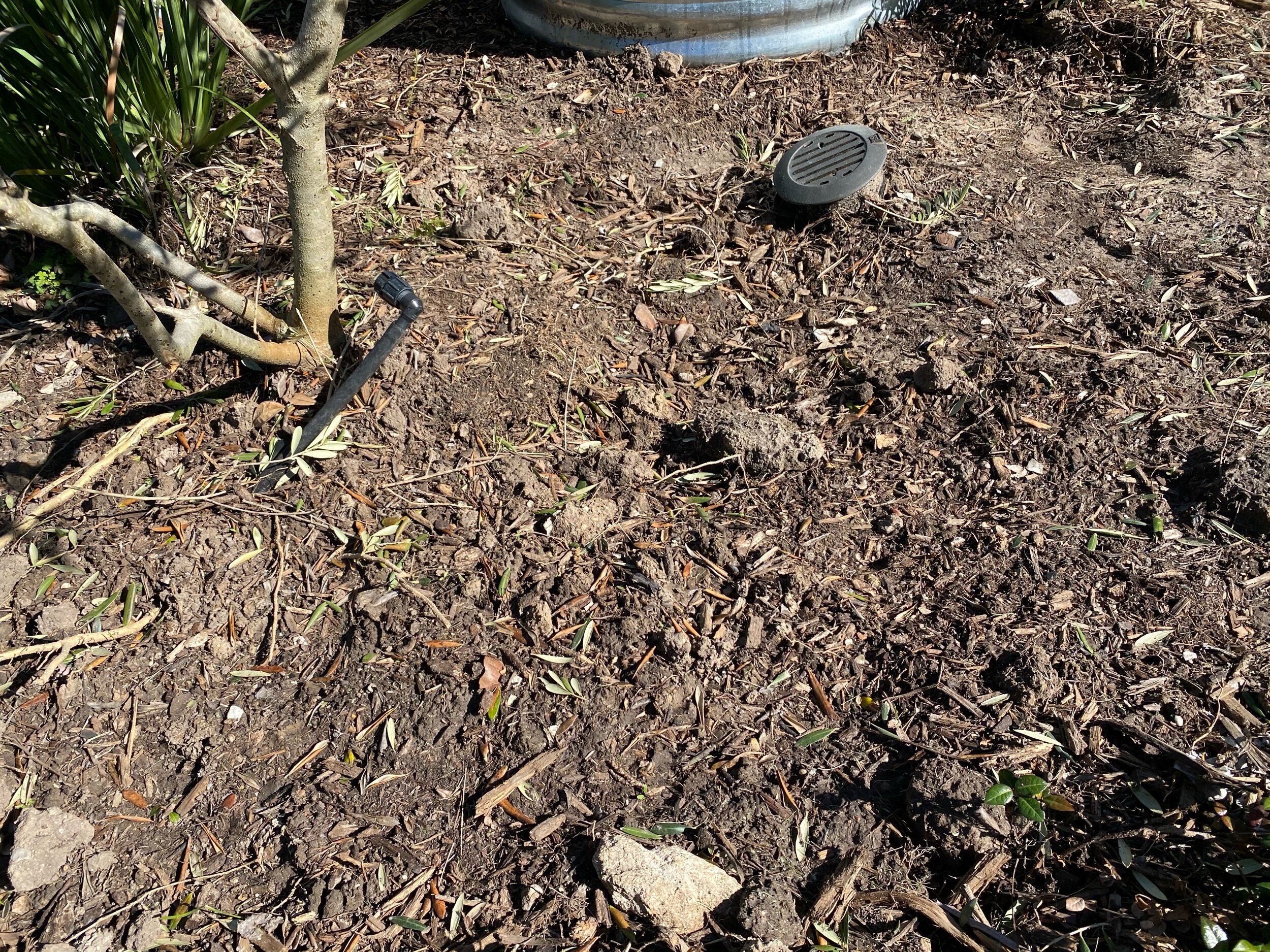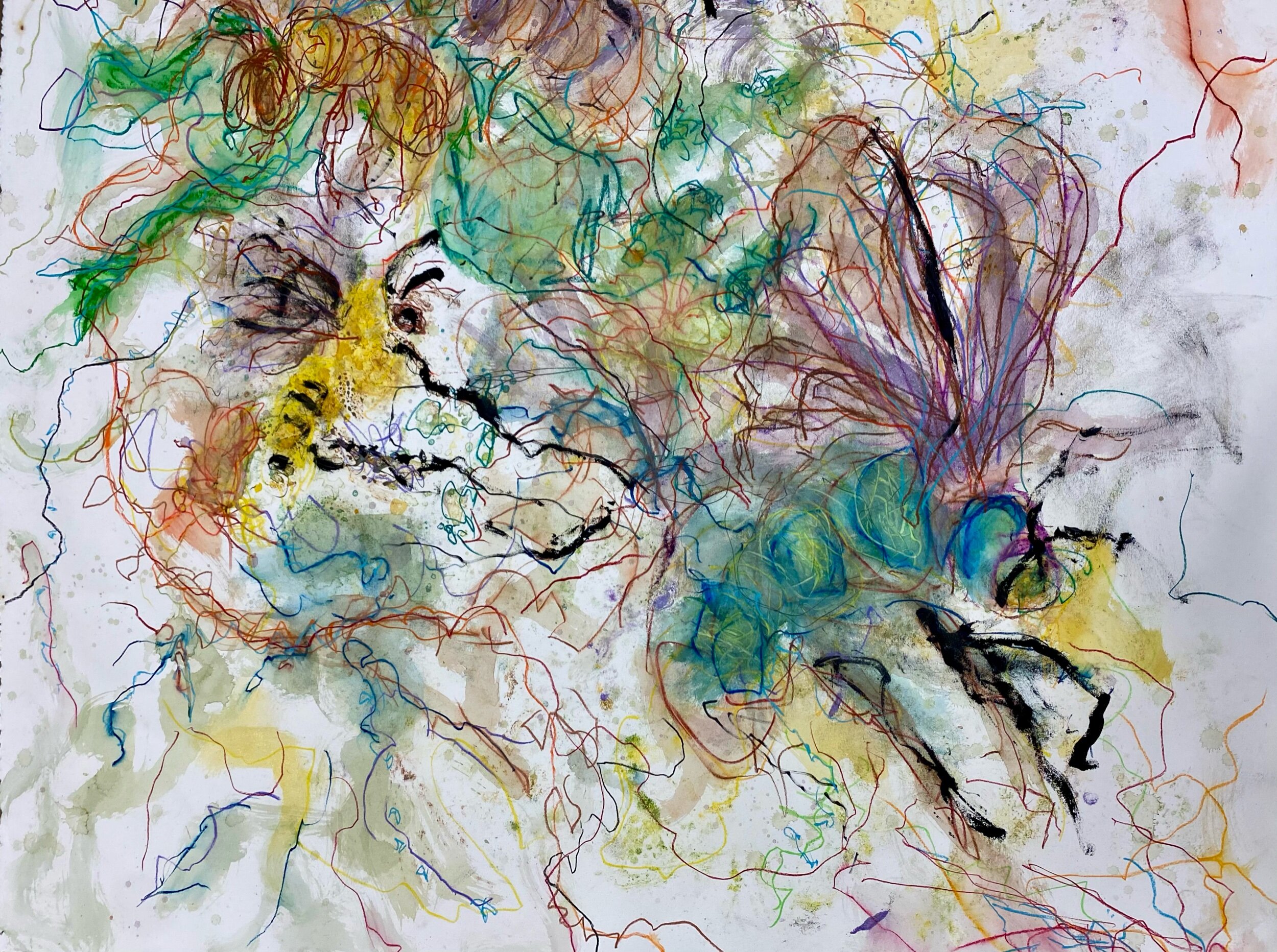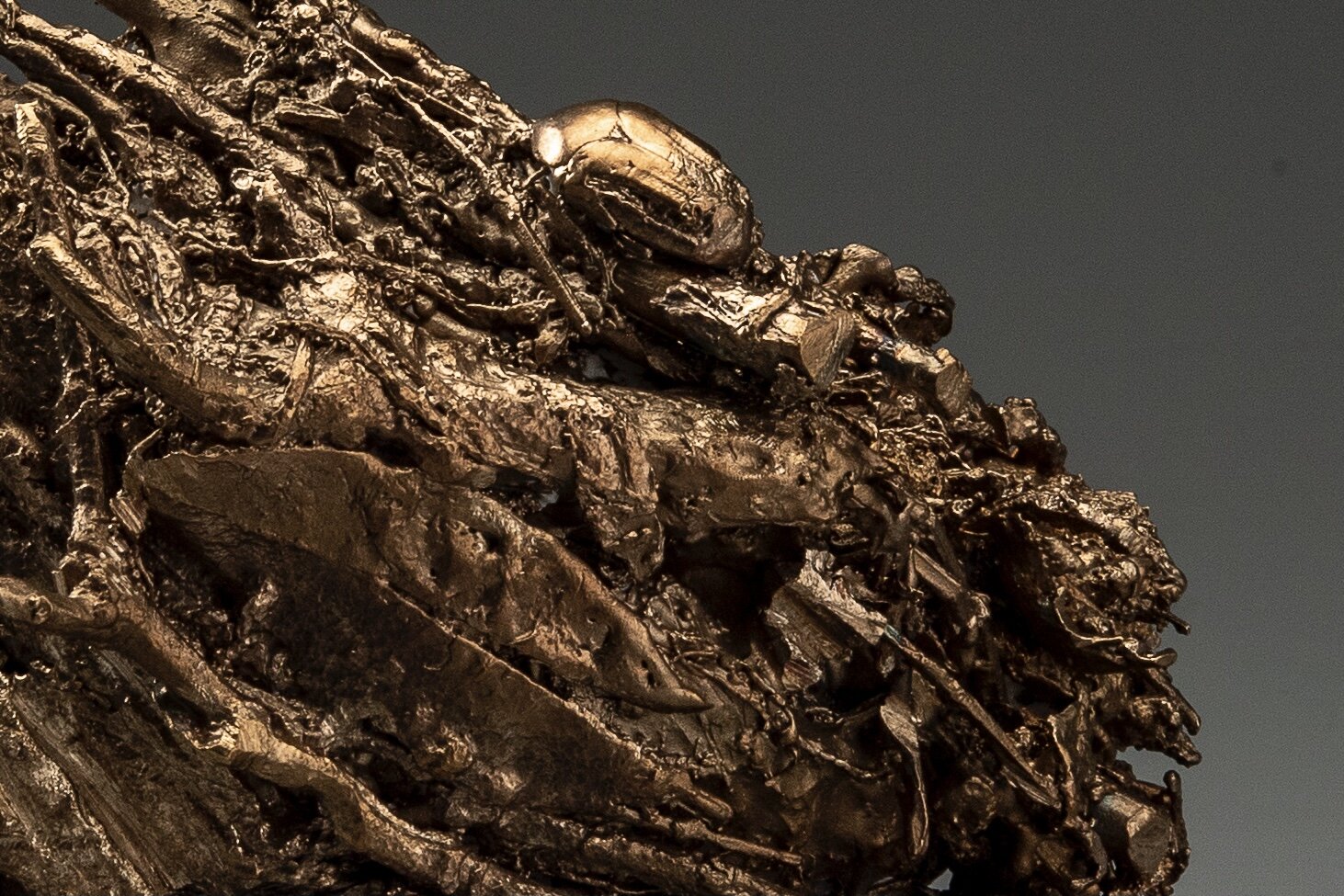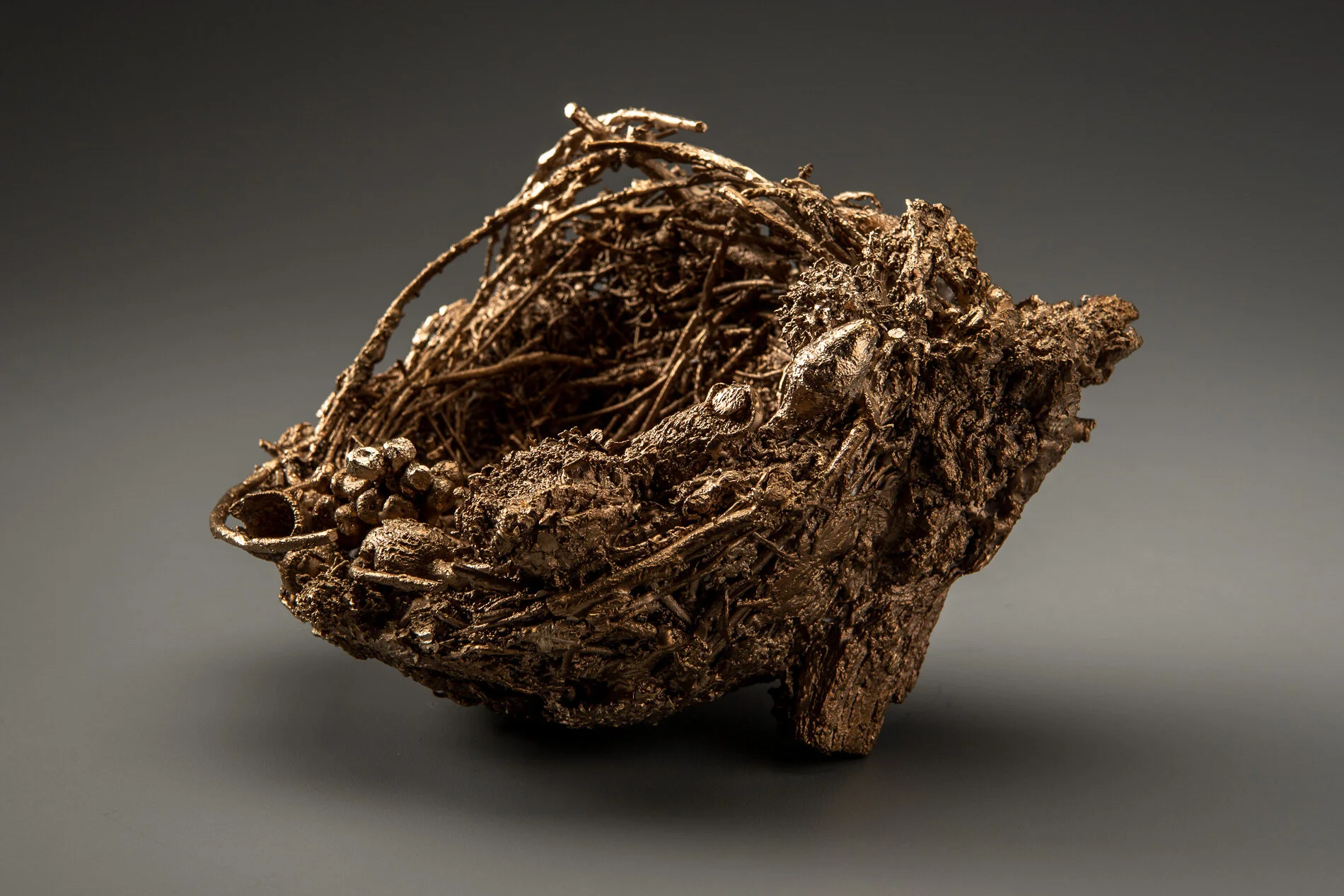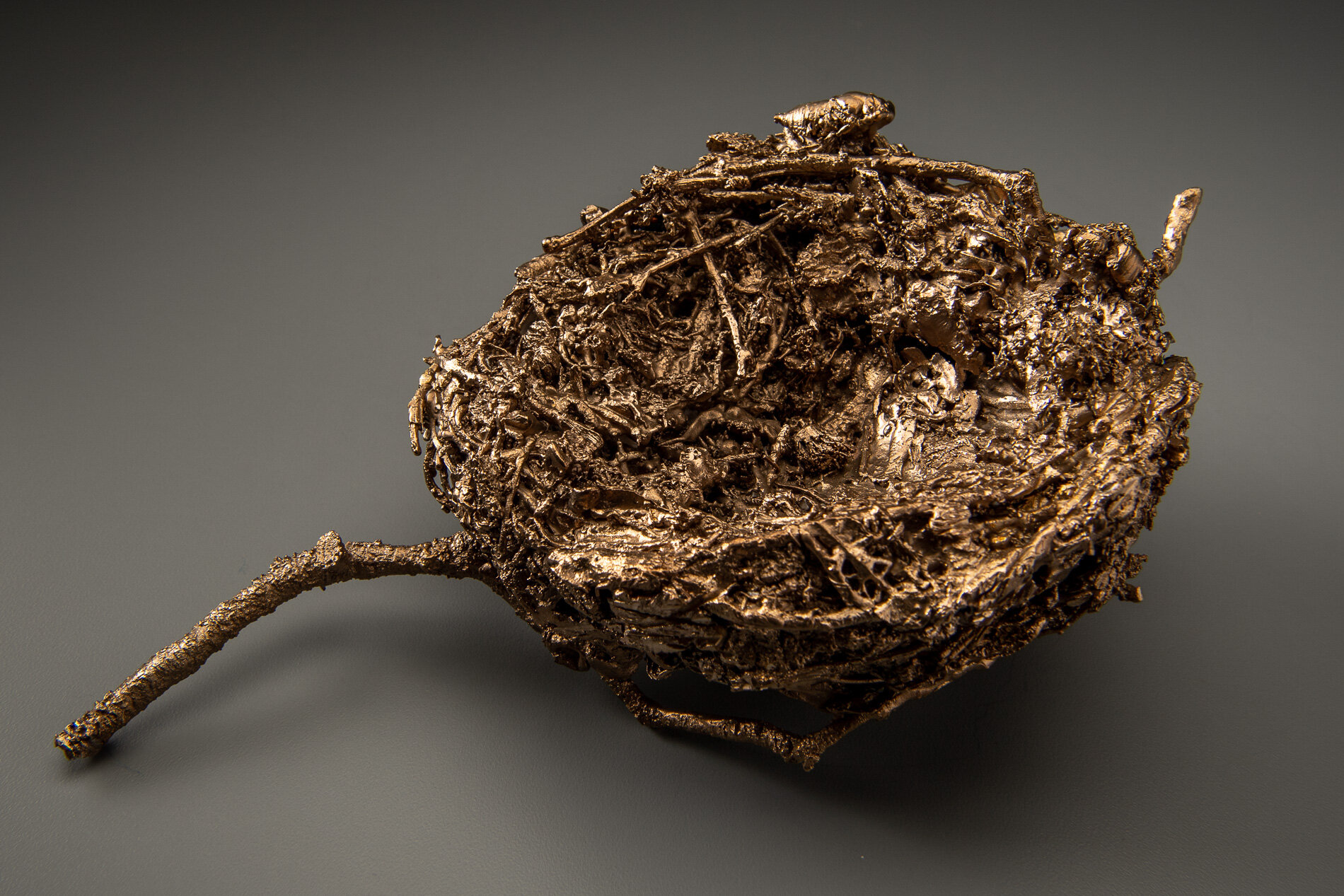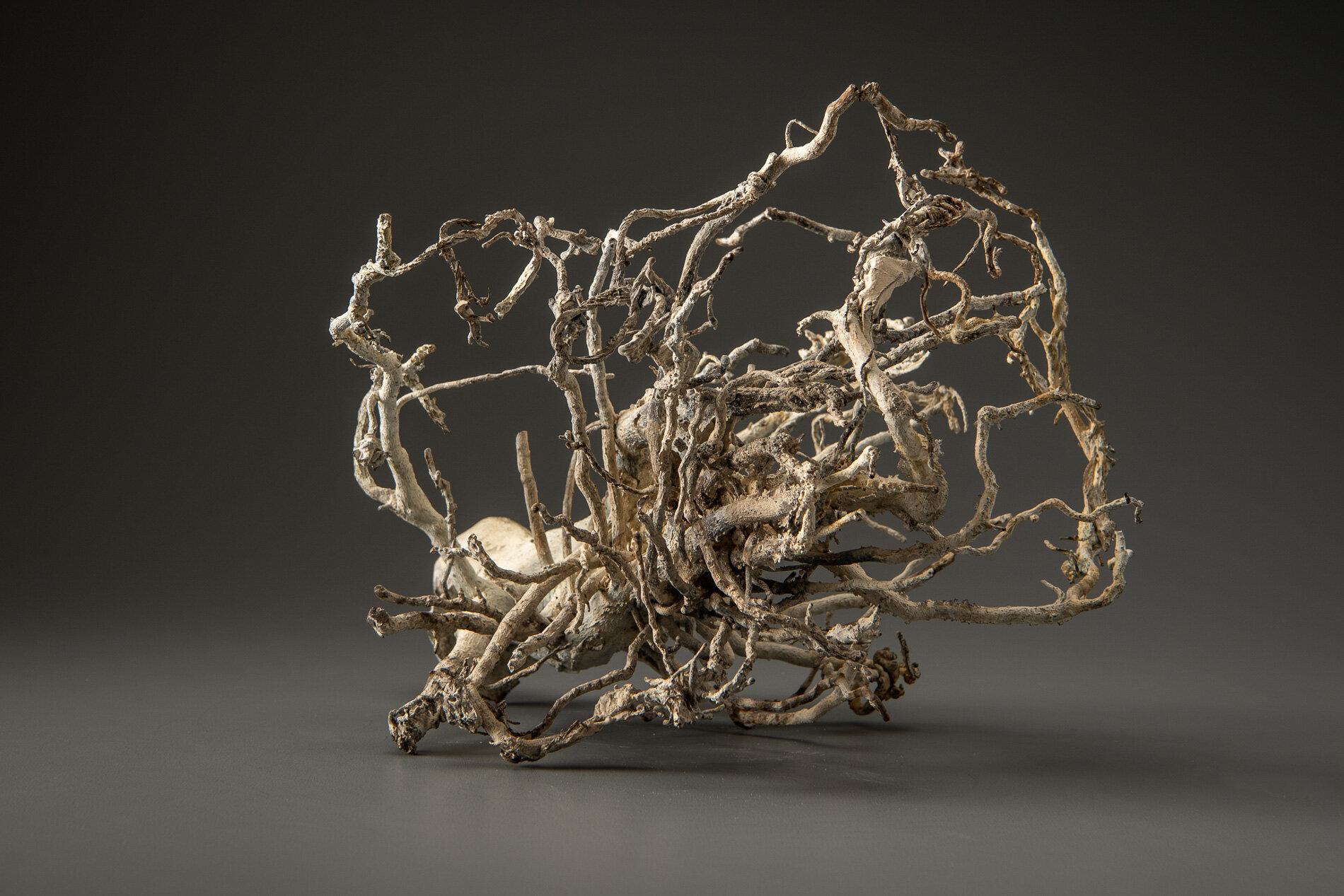Lawndale symbiosis - milkweed and monarchs
I have read that a few migratory monarchs spend the winter in the Houston area and join a small resident population of monarchs. I have also read that it is essential to choose native milkweed as opposed to tropical. Tropical milkweed—doesn’t die back in the winter as native milkweed does. When a place to lay their eggs year-round is available, many monarchs don’t bother making the trip to Mexico.. I saw this caterpillar on my morning walk. It was seriously munching on the milkweed. Milkweed is the only plant that provides the nourishment that will transform the caterpillar into a monarch butterfly. It is important to plant only none-hybrid native milkweed. Texas milkweed will be included in my 2021 Lawndale Art Center Sculpture garden piece Symbiosis. In Symbiosis, I am stretching my practice and creating a living piece of site-specific art activism that will reimagine a 53.5’ X 48’ traditional urban landscape/sculpture garden and answer the question: how do we holistically restore an ecological balance in Houston? Symbols is a collaboration with Lawndale Art Center’s community, neighbors, urban wildlife, and the coastal prairies' carbon cycle. For more details see this link.
#carboncycle #cindeeklementart #texasart #houstonart #contemporaryart #modernart #caterpillar #monarch #milkweed #nativeplants #migration #energy #movement
#lawndaleartcenter #symbiosis #artactivism
The day after the caterpillar sighting.
The beauty of a leaf runs deep.
How beautiful droplets of dew or rainwater puddle on the waxy leaf surfaces? They provide the watering holes for nature’s tiniest creatures.🐞🐛🕸️🦎🐌🐸🐜🦋🐝
What do you see when you see a leaf? ☘️🌿🌱🍀
I see a unique natural system. Leaves multi-functioning as micro reservoirs, coats of armor protecting the soil, and micro floodgates slowing rainwater. 💦🌊💧
On the Coastal prairie, leaves function to protect the soil from being compacted by the pelting raindrops. If the heavy raindrops fall is not broken by layers of leaves and organic matter, the tiny cavities in living soil collapse, and rainwater moves horizontally across our landscape instead of into the tiny reservoirs in the soil. We need these small cavities to allow water to penetrate deep into the soil. Leaves also slow rain droplets giving the soil time to transport the rain to its deepest roots. Once the rain is in the ground cooling our planet leaves protect the soil from the heat of the day. This multilayered ground cover gives rain more time to trickle into the aquifer. Purifying our water and cooling our planet. How amazing are leaves? As an artist my how we see urban landscapes
My work records endangered knowledge to the collective memory and reimagines urban landscapes to holistically balance the needs of humanity and wildlife.
In Symbiosis I am stretching my practice and creating a living piece of site-specific art activism that will reimagine a 53.5’ X 48’ traditional urban landscape/sculpture garden and answer the question: how do we holistically restore an ecological balance in Houston? Symbiosis is a collaboration with Lawndale Art Center’s community, neighbors, urban wildlife, and the coastal prairies carbon cycle. #symbiosis #lawndaleartcenter #urbanlandscapes #artadia #coastalprairie #water #leaves #conservation art #bioart #nature #contemporaryart #modernart #artactivism #cindeeklementart #texasart #houstonart
Symbiosis - Living environment affects the microbiota and health of both dogs and their owners
Every morning I start my day reading an email from Sciencedaily.com. I read the environmental and health-related research news, scanning for articles that relate to my environmental/conservation sculptures and monoprints. The article Living environment affects the microbiota and health of both dogs and their owners Is an exciting read for me. My World of Hum kinetic sculpture was inspired by the impact pesticides have on native bee microflora and one aspect of my current work in progress Symbiosis at Lawndale addresses soil microbes in the sculpture garden.
Visitors are relaxing in the garden during a performance piece at the fall opening event.
Dogs are a large part of urban living and, surprisingly, at Lawndale Art Center. Every other day I stop by Lawndale to study the garden, looking for any changes in the soil, leaves, vines, pond water, and look and listen for any wildlife. Often I run into neighbors of Lawndale with small dogs that visit the garden. Stephanie, her four-year-old daughter, and King Charles Spaniel also spend time together enjoying the outdoors in the garden. Sometimes on Sundays, I bring my labrador Tobi with me. It is hard to judge the impact of urban landscapes on those who visit these green spaces with their pets. Living soil unquestionably has an impact on our microbiomes and our pets as well as supports urban wildlife. One of the most interesting books on the subject of our microbiome is I Contain Multitudes by Ed Yong. Dogs
Basically everything we do impacts our microbiomes. In order to build a healthy immune system a key element in any environment is diversity. My sculpture Symbiosis will be have a positive affect on the microbiota and health of both dogs and their owners who spend time in the garden.
Symbiosis- fluffy bluestem
Through art, I am finding new ways to see Houston’s urban landscapes. The bushy bluestem is a coastal prairie native and a volunteer at Lawndale art center, the location of my 2021 site-specific sculpture installation.
For creating movement and living soil, bushy bluestem is a fabulous material to consider. At this point, I do not know if it will make the cut of materials for the sculpture; however, it does have some attractive characteristics as a material for living soil, and aesthetically I think it is beautiful. The spikelets of silky feathers curl out of a sphere of fine hairs. It is tall and graceful, peering five feet off the ground. In my mind, I can see a cluster of them suited in costumes of golden cotton candy swaying across the stage of coastal prairie under the spotlight of our earth's closest star. Their rhythm succumbs to the breeze that sweeps off the coast. They create the perfect; kitchen of seeds for birds and small mammals, cozy nesting materials for birds, winter food for prairie chickens, field sparrows, and juncos. I can hear a symphony of songbirds serenading the morning as butterflies flit, and flingle and native bees start their day. With close inspection and a little luck, you may even discover a Skipper or Satyr larvae starting a new life amongst their stems. #symbiosis #cindeeklementart #livingsoil #sitespecificart #texasart #bushybluestem #houstonart #texassculpture #contemporaryart #nativebees #bees #wildlife #livingsoil
Changing how we see urban landscapes in Houston.
Grasslands vs. trees
When it comes to the environment in the 21st century grasslands beat trees when it comes to carbon sequestration. Our planet is a living breathing organism, impacted by our actions, always changing. I believe It is important that we constantly observe and evaluate how it changes as humans developed and expand across it.
Trees are a thing of beauty but they store carbon above ground in their trunks and limbs.when they catch on fire the trunks and limbs release their carbon into the atmosphere. Grasslands storing carbon underground release little carbon when they catch on fire. In addition the grasslands are a giant sponge soaking up water that prevents dryness and fires.
With the forest fires we have suffered world wide it is time to plant more grasslands and turn these areas suffer ending from droughts into giant sponges for soaking up water and carbon. When the ground is moist then we can can start adding back trees.
Drying coastal prairie native grass in my studio.
I felt like Sally Fields
I feel like Sally Fields at the end of her A Awards acceptance speech- anyone my ages remembers how funny that was. I always think of Sall F. When I think of being grateful when I get any positive feed back for my art.
This has to be my most liked Instagram post. That should tell me something. I guess I will be officially finding a way to combine Rumblings and the World of Hum. 🤔🤠🐝
ROOT TO WATER
”Root To Water” 24” X 12” X 12” irrigation wheel and root found objects.
“How fleeting are the wishes and efforts of man! how short his time! and consequently how poor will his products be, compared with those accumulated by Nature during whole geological periods.”
—Charles Darwin, Origin of the Species
Root to Water offers hope. The root, placed with the root system up, takes on anthropomorphic characteristics, as the wide spread irrigation wheel’s legs are firmly grounded, the humanized root’s bent over posture and downward pointing arm are alive with discovery, the root’s hair like tendrils are actively rewiring its human anthropomorphic brain. This rewiring is happening across the globe, in the most desolate of landscapes citizen conservationists are studying natural law and finding solutions to their man-made problems.
In Root to Water, the irrigation wheel symbolizes mechanistic systems. The root in its natural state represents ecological systems. With this duo, I propose that modern civilization has reached an advanced stage of industrialization. In order to progress to the next stage of civilization we must heed Darwin’s observation, and answer the question how do we pair mechanical innovation with the systems that have functioned through “whole geological periods.” I placed the root above the wheel supporting Darwin’s view of natural systems superiority to human innovation.
Repurposing two tools from agronomy, Root to Water shifts how we see mechanical systems versus naturally occurring systems. In this sculpture, a modern innovation—a rusting, decorative, human-made irrigation wheel—serves as a pedestal for an organic found object that often goes unseen: a root system. With this pairing, I exhibit man’s historical struggle to transition to an agricultural-based society utilizing human-made innovations that extract natural resources instead of harnessing existing ecological systems that regenerate resources.
Communities across the planet are experiencing extreme cases of natural disasters. Houston has experienced three 500-year floods in three years. The U.S. Army Corps of Engineers completed the Buffalo Bayou and Tributaries Resiliency Study, proposing options for controlling flood waters costing up to $12 billion. The report does not include conveyance options that are local nature-based cost effective solutions.
A growing number of conservationists are using natural systems, specifically roots, as a tool for water transportation, carbon sequestration and as a means to cool the planet. Meanwhile, industrial agricultural produces products that are depleting the organic matter, releasing carbon from the soil, and contributing to global warming. As evidence consider, “Each 1 percent increase in soil organic matter helps soil hold 20,000 gallons more water per acre.” In contrast, industrial methods strip the soil (releasing carbon), use petroleum-based inputs to enrich the soil and kill pests. Root to Water elevates roots as a natural system that transports water, minerals and carbon; stabilizes soil; and is instrumental in cooling Earth’s surface—a live-able solution for global warming.
My research-based art looks at the natural history of living soil and how it can be used to restore natural resources that is not commonly understood. I champion natural solutions to environmental issues with a focus on urban landscapes. Root to Water is part of my Endangered Knowledge work, a body of work in progress.
“Though the problems of the world are increasingly complex, the solutions remain embarrassingly simple.”
—Bill Mollison
Further Reading
-Judith D. Schwartz, The Reindeer Chronicles, Water in Plain Site, and Cows Will Save the Planet
-Kiss the Ground, Directed by Joshua and Rebecca Tickell, with WoodyHarrelson
-Organic Matter Can Improve Your Soil's Water Holding Capacity
-The Loess Plateau was the, most highly erodible soil on earth”
Talking roots.
How roots talk to each other. My focus is coastal prairie roots, but I expect roots of grass communicate as tree roots communicate. We gave only begun to learn from roots.
SUBTERRANEOUS SECRETS IV
36” X 8” X 8”
bronze
photo by @nashb Baker
Since the beginning of time, the human spirits' imaginations have been magnetically allured beyond the earth's geomagnetic field, inventing robots, orbiters, landers, and rovers to explore outer space, searching for celestial organisms — fruitlessly.
Secretly between 100 million and 500 billion microbes per teaspoon are living a subterranean life underneath our feet. Living soil is the root of our existence; it is essential to life on Earth. For several years, I have researched grass-fed food production, attended soil conferences, and visited regenerative ranches. (my favorite is @roamranch) Research in these fields reveal how to fight desertification and reverse climate change through regenerative agriculture practices. Interestingly, this natural history of living soil, how it evolved with roots, fungus, plants, food, and animals, carbon and their essential roles within microbial communities in human health, is not common knowledge. Subterraneous Secrets excavates this crucial tool in storing carbon. My work finds new ways to reimagine urban landscapes and records natural history to the collective memory so that it will no longer be endangered knowledge #roamranch #cindeeklementart #bioart #conservationart #environmentalart #root #bronze #bronzesculpture #pesticidefree #texasart #texasartist #houstonart #houstonartist #houstonsculpture #nature #naturalsystems
Armadillos and termites
Termites - to quote @gjklement,” termites are the ultimate grazers” last week, after we harvested our turkeys @roamranch, we went on a hike along the pastures to Indian Cave Creek. Along the way, we saw an abundance of armadillos eating termites. This trip was my 6th trip to the ranch and the first time to see any armadillos on the property, much less numerous armadillos or notice any termites. It is a sign the soil is regenerating - it is a good thing. Armadillos play an essential role in the Texas landscape both in agricultural settings and in urban population centers. They eat Termites keeping them in check. The termites are essential in building functioning ecosystems. As an art activist, I want to change the way we see nature. #regenerativeagriculture #regenerativeart #cindeeklementart #bioart #cobservationart #artactivist #texasartist #houstonartist #womansculptor #art #sculpture
Why Houston is in the perfect position to save the bee
Rural areas are highly impacted by the unanticipated consequences of our industrial agriculture’s dependence on chemicals that weaken bee’s immune systems. Urban bee populations can be more diverse than in rural areas. Researchers are finding in cities such as Chicago, Berlin, Berkley, and Melbourne that have reimagined their parks, neighborhoods, city centers, vacant lots, street medians, and rooftops planted with native flowers, grasses, and fruit, and vegetables support healthy, vibrant wild native bee populations.
In the US, there are four thousand native bee species. They pollinate over three hundred times more effectively than honey bees. For example, A single female Leafcutter Bee visits 100,000 plus blossoms per day whereas a honey bee visits 50-1000.
Houston covers 600 square miles of land and has one of the longest growing seasons in the U.S. As it continues to sprawl across Texas, its gardens must increasingly become a refuge for native plants and animals. With 2.3 million people living in the most vital economic, cultural center of the south, we can become the most critical urban native bee habitat in the United States.
I have spent the last year and a half studying the bee situation as it pertains to my art and my interest in regenerative agriculture. I am determined to take this knowledge and save the bee in urban settings.
With Houston's land size, population, and location in the Sunbelt like it or not-we are impacting the bee population.
ADDITIONAL LINKS
If Cuba can create urban gardens to feed its poor can you imagine what we can do
Symbiosis building soil life.
How do you build soil health without having the luxury of animal impact. It is one thing to build soil health on a bison farm. The microbes in the the the bison, turkey, pig and chicken dung builds the life in the soil. In the sculpture garden at Lawndale I am going to use LEAF MOLD COMPOST. This product is produced primarily from recycled leaves, with a little grass and horse manure mixed in, a touch of fruits and vegetables. After a long slow compost it will be rich in beneficial microbes. It will help save water and promote healthy soil. I was going to wait until early spring before we replanted the garden. However, Sunday Lawndale is having it's Sunday brunch fund raiser. And this is in the day if Covid 19 so the event is outside. I noticed that the heavy rains of late have compacted several areas in the beds and washed away some soil. It will be an opportunity to to talk about living soil,
I spent time researching different types of compost and mulch. Natures Way Resources compost native plants, is locally owned and located in the Houston area. The owner is a soil scientist. I had a long conversation with him today and he really knows living soil. I can't wait to see life return to the garden.
Here you can see how the soil is wearing away without having plants/roots hold it down. You can also see how the rain hitting it had compacted the ground. When the soil becomes compacted it stops absorbing water. .
The goods
The tools
Happy Soil Day.
Happy National Soil Day. Notice the length of the root system of this turf grass-just a few inches. 👎
🤔
The image I posted is not soil to be celebrated.It is what I call mindless conformity 🤨AND - now for the good news- 🌱☘️🍀☘️🌿
It is an opportunity to help save our planet and that we should celebrate.
Let me explain- this is the typical ground cover that covers 99.99% of the homes in the United States. It is a mono-crop of turfgrass. Monocrops are not healthy for soil. Mother Nature needs diversity to be healthy. To go against nature, homeowners have to apply chemical inputs to keep their monocrop turf grass looking perfect. These fertilizers, fungicides, herbicides, and pesticides kill all the living matter. They also kill our insects and valuable Keystone species.
In contrast, healthy soil, especially on the coastal prairie, is a sponge for soaking up rainwater and keeping our planet cool. Houston was a coastal prairie covered in native grasses that had massive roots systems. Some extended 18’. The coastal prairie has the capability to absorb massive amounts of moisture/water. They also act as a filter to clean the water and retain water. Water held in healthy soil is how the planet cools itself. Healthy soil also sequesters carbon out of the air and puts it back into the soil. The coastal Prairie plays a large role in the global environment. Houstonians have paved, asphalted, and covered in turf grass 600 square miles that makeup Houston. Reimaging urban landscapes is an opportunity to save our planet. Turfgrass covers more acreage in the US than farmed land. 🤠 this is an easy way to comply with mother nature. I am using ny art to find ways to reimagined urban landscapes to work with mother nature Healthy soil= healthy people. Happy soil day. #cindeeklementart #artactivism #bioart #soilart #art #conservationart #soil #regenerativeart.
Shoutout HTX
Anytime an organization or individual takes notice of my work it is a gift. Thank you Shoutout HTX for supporting me and other local artists.
Army Corps of Engineers study
The Army Corps of Engineers study to reduce flooding risk does not consider utilizing any nature-based solutions. Here is a fascinating discussion of nature-based solutions that will not cost $1 -$12 billion.
“How fleeting are the wishes and efforts of man! How short his time! and consequently how poor will his products be, compared with those accumulated by Nature during whole geological periods.”
—Charles Darwin, Origin of the Species
I was already working on this piece and the artist/activist/conservationist statement that it visually supports. I am excited to get it photographed and out to the public. There is no question that Charles Darwin had it right. Before we spend $12 billion and wreck the Katy Prairie and Buffalo Bayou let’s review a study by bioengineeers.
”We see nothing of these slow changes in progress, until the hand of time has marked the long lapse of ages”-Darwin
Darwin’s observance is no longer correct, As we continue to expand our cities we have have ramped up the hand of time, we are fast-forwarding and witnessing evolution. This can be good or it can be bad. Millions of species going extinct on our watch is not good; there is a benefit to seeing the effect of our actions. This knowledge is power, join me and decide to change the way we see urban environnents, and act accordingly. We can write our own evolutionary script. We can return to protecting natures .
Reimagining urban landscapes- how plants and animals are evolving in cities.is an eye-opener.
World of Hum- a humdinger
Keystones in El Paso
50” x 10’
watercolor monotype
Another conservation benefit from COVID 19 - Sea Turtle numbers are up during 2020
It is amazing how naturere can reguvinate itself when humans step back. We should ask our selves what does this tell us? How can we benefit from this observation?
Green turtle nests:
2020: 8,110 (unexpectedly high for a "low year")
2019: 15,784 (record, "high year")
2018: 1,230 (typical "low year")
Loggerhead nests:
2020: 12,968
2019: 10,813
2018: 11,901
Leatherback nests:
2020: 40
2019: 36
2018: 17
These watercolor monotypes are the pieces I discovered my technique on.
Fragility study 30” X 22”
Here I experimented with how wet my paper was. I love the running color on this particular piece. It would not work for everything.
Fragility- Kaleidoscope
2017
Watercolor monotype
30” X 22”
Same Time Next Year
Detail of common beetle from my urban Explorations.
The sidewalks in my neighborhood are my nature trail. I walk with my eyes on the prowl for intriguing insects, exoskeletons, insect wings, feathers, dried flowers, twigs, leaves, seeds, and pods — things my children’s eyes taught me to find during our walks together over the years. Since 2013, these biological mementos have found their way into my bronze work in the molds of nests. Each piece is a reflection of that year’s ecology and records the time and movement of environmental restoration. Initially, I was unaware of the landscape around me, but as my art dove deeper into environmental restoration and Hurricane Harvey changed our city, I realized that my days are, in fact, full of sterile surfaces. With COVID-19 quarantine, children in my neighborhood started venturing outside and looking for things to capture their curiosity. Delighted with their new interest, I realized that the green spaces and puddles children explore now are no longer filled with a diversity of life; the box turtles, bullfrogs, tadpoles, bumblebees, and assortments of flitting insects have evaporated with the spray of insecticides and herbicides in our neighborhoods. The selection is reduced to cicadas, the common beetle, honeybees, a rare native bee, and an abundance of Cuban lizards that dwell in turf grasses, boxwoods, crepe myrtles and oaks. I have awakened to cultural landscape uniformity. COVID has changed how I see the need for perfect lawns; the dirty truth is mosquito home-misting machines, obsessive weed control, artificial turf and a lack of plant diversity have turned urban neighborhoods into manicured monocultures for humans exploring video games. These habitat changes in massive population centers are fast-forwarding evolution: loss of wildlife habitat is one of the biggest threats facing many animal species. This does not have to be—it is a societal choice, the ability to speed up evolution can go both ways. Through my works – Lawndale’s Symbiosis, Endangered Knowledge: The Soul of Humus, Gust, World of Hum, Rumblings and Root to Water—I am committed to creating work that educates and helps communities change how we landscape our cities to include valuing the natural world and turning back the evolution. In Dirt to Soil, Gabe Brown quotes Don Campbell, “If you want to make small changes, change how you do things, if you want to make big changes change how you see.” When I come across intriguing flora or fauna on my urban trail, albeit few and far between, I see them as evidence that can inspire a revolution in the landscape. If they are expired and will not decompose, I collect them. I see these bronze cast nests as urban wildlife fossils—biographies, every year a chapter recording Houston's environmental awakening. As an optimist—environmental—art—activist my work focuses on revealing endangered knowledge to change how we see urban landscapes and activate cooling the planet through our cityscapes. As migratory birds return year after year to build nests and raise their young, I return with optimism in my step. I envision witnessing the return of four hundred plus butterfly species and eight hundred bee species native to Texas. I can see this returned wildlife capturing my future grandkids' imaginations. I will tell them the story of how insects almost disappeared and how every yard is a micro-ecosystem and matters. I imagine their hands building nests with a diversity that I cannot imagine. I hear their voices telling me in one breath about the fuzziest-biggest bee they ever saw, covered in golden dust nesting in a patch of ground beneath the sunflowers not far from the silverleaf nightshade. I see them bringing me a tail-feather from a Red Shoulder Hawk and asking, "what does it hunt" and is it the bird that sounds like the squirrel's screech. After a rain, I see them finding two bullfrogs attached and their tiny ribbons of floating eggs in a pond. I hear them tell me not to touch the caterpillar of the southern flannel moth, and asking me, “how does it sting?”. At the low of evening when dragonflies hover; I will watch as they study the night heron’s quiet solitary stance as it stalks small citizens of the grass, I will smile as they question the raucous warnings of ravens and the scoldings of nut collecting squirrels. I will feel their excitement when neighborhood raccoons appear from storm sewers and scavenge treats from dog bowls and opossums waddle fence lines, searching out grubs and open garage doors. I will follow their eyes when the silent patrol of the lone coyote visits the shadows of our boulevards from their bayou bound dens. I let them sleep outside and hear their heavy eye lids ask, why do the owls ask who? I listen as they wake up to a concert of white-winged doves. I will feel peace when they are wise to nature.
SAME TIME NEXT YEAR 2019
4.75” X 10” X 5.5”
bronze
SAME TIME NEXT YEAR 2018
5” X 9” X 7.5”
bronze
photo by N. Baker
SAME TIME NEXT YEAR 2017
4" X 13" X 8"
bronze
photo by Nash Baker





